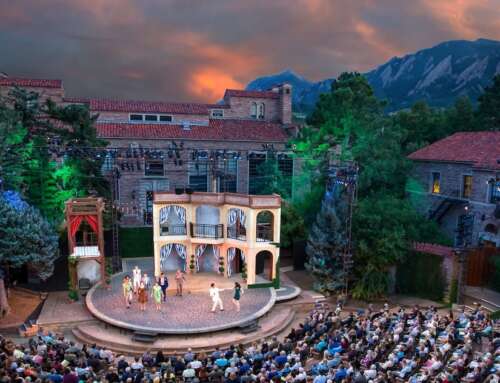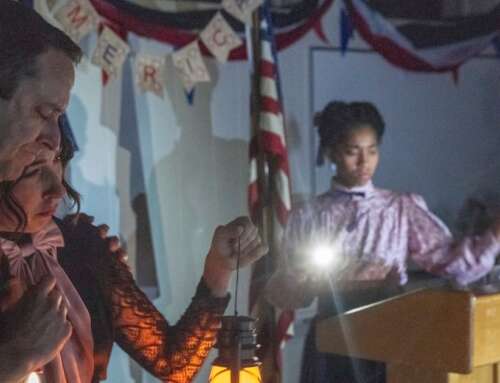At Miners Alley, Sarah Ruhl’s ‘The Oldest Boy’ asks a lot of the audience
The prolific, award-winning playwright Sarah Ruhl has done it again, expanding the germ of an idea into a full-length play currently being staged at Miners Alley Playhouse in Golden. The Oldest Boy – A Play in Three Ceremonies captures the soul of Tibetan Buddhism and more precisely the difficulty confronting a family — and especially an American mother — when her 3-year-old child is said to be a reincarnated lama and is therefore being called back to India for “enthronement” and all that involves.
But the play is more than simply a lesson in reincarnation and the beliefs of practicing Buddhists and spiritual reckoning. An overwhelming theme in the play is the question of parenting and motherhood as explored by the character Mother (Lisa DeCaro) and Father (Peter Trinh) — himself a practicing Buddhist. When a Lama (Tessa Fuqua) and a Monk (Tim Inthavong) arrive unexpectedly to deliver the news, both parents are taken off guard by the notion that their son may be something other than an average 3-year-old boy. Both are conflicted about the fate of their son and all that it entails.
We are next introduced to the son — the Oldest Boy — in the form of a 2-foot-tall puppet, designed by Cory Gilstrap, along with his handler, Rob Payo, dressed in black. Although scripted in this fashion, there is more than a moment of reckoning needed to allow for the puppet to come alive and in turn, deliver the sense of believability necessary for it to function within the parameters of the script. The cast treats the puppet as a real-life character in the play, which does guide the audience to do the same. But still, this is a unique characterization that at times is both fascinating and unclear. The audience is called upon to suspend belief and accept the doll-like figure as an equal participant in the play — not an easy task.
DeCaro gives a fully developed performance as the mother in the throes of losing her son while grappling with spiritual doubts. She is both a loving mother and a question-filled spouse. Her transformation from start to finish is fascinating to watch and absorb. She makes the wheels turn in this play and does so with a top-notch performance.
Trinh, Fuqua and Inthavong give modest performances, mostly called upon to service the play and Mother’s intense journey. Trinh’s character provides stability to Mother’s hard-fought reconciliation that she must give up her son for the betterment of the world. Fuqua and Inthavong both provide the news of the Oldest Boy’s calling in a very matter-of-fact manner that at times is too understated. They are both called upon the share an abundant amount of information regarding Buddhism and do so with a sense of deep knowledge regarding the subject.
Ruhl’s script could have done more to portray the high stakes involved by filling in detail about the significance of the family’s sacrifice. Why must the child be removed from the home altogether at such a young age? What is the role of a lama, exactly? And most importantly, what does the family gain by handing over the child in the first place?
As the Oldest Son, Payo handles the puppet with great agility and a sense of realism. Payo uses his voice to provide dialogue for the Oldest Son and does so

Rob Payo is puppeteer and voice of the son | Photo: Sarah Roshan
believably. However, it is difficult to judge his performance because of the overall quality that the puppet projects. With a frozen expression on its face, there is no possible comparison attributable to that of the other actors. I may challenge Ruhl’s use of a puppet in place of a human actor, but of course finding a 3-year-old capable of giving a full-fledged performance would be next to impossible. It’s a unique feature of the play and one that the audience will either accept or not.
As directed by Len Matheo, the play moves swiftly from start to finish, however, there is little deviation in the energy and focus from scene to scene. Although Ruhl has included a lot of ground to cover, there needs to be greater reverence for the script to really delve into the multiple layers it provides. It is a solid production, but one that lacks a well-intentioned vision necessary to tie it together.
The set designed by Jonathan Scott-McKean and the costumes designed by Crystal McKenzie both evoke strong feelings of Buddhism and a totally distinct landscape. The lighting designed by Vance McKenzie is suitable for the small space depicting various locales.
The Oldest Boy: A Play in Three Ceremonies presents many challenges for Miners Alley to stage. It is a fascinating and unique theatrical piece that deserves an audience and much appreciation for Miners Alley’s overall commitment to the play and this production.
Eric Fitzgerald started producing plays when he was 5 years old. He spent eight years in New York City as a talent agent representing well-known actors and actresses. Fitzgerald also worked for the ABC Television Network for 12 years both with ABC News and ABC Daytime. He lives in Aurora with his cat Max.








Leave A Comment